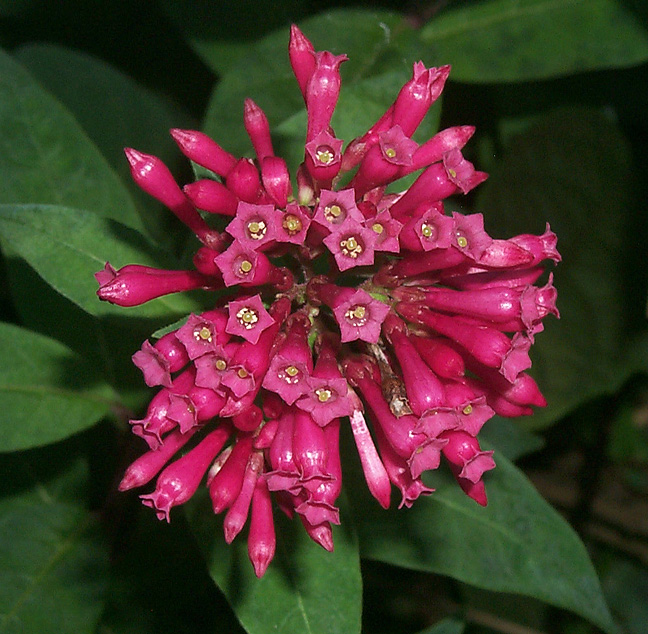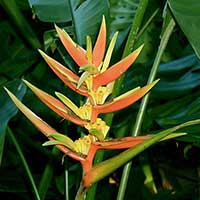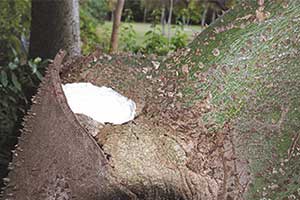
An IPM program for growing tropical plants using cultivation techniques

Association of Zoological Horticulture 1991 Conference Proceedings
When an Integrated Pest Management (IPM) program is evaluated, the use of beneficial insects and disease-resistant plants are usually acknowledged as the main tools of such a program.
Cultivation methods, such as controlled watering, pruning, and mulching, are not covered very well in texts about IPM (Yepsen 1985, Horn 1988, Olkowski et al 1991). This article will attempt to show how cultivation techniques can aid in pest and disease control.
Controlling the amount and quality of water a plant receives is important not only from the aspect of plant growth but also to prevent insect and fungal problems. Stress caused by wilting has the same effect as senescence. Moisture deficiency accelerates leaf protein breakdown, causing an increase in the nitrogen content of the phloem sap and in starch hydrolysis which increases the sucrose content of the phloem (White 1984, Smith 1989). These reactions have shown to be a critical factor in the population growth of many insect herbivores (Holtzer et al 1988).
Allowing plants to wilt has shown an increase in the development and survival of plant feeding aphids (Smith 1989). Stress through summer drought and excess soil water in winter was implicated in the increased survival of larval looper caterpillars (White 1974). Fungal problems in plant roots are often caused by excessive watering and poor drainage which can be alleviated by a more porous soil medium. High amounts of soluble salts can build up in the soil due to poor water quality affecting plant health.Specimen or bedding plants can be permanently grown in containers to allow the horticulturist to change a display often without damaging the plants.
When there is insufficient light or cool temperatures causing damage, containerization will facilitate the easy movement of the plant to the nursery where it can be grown under optimum conditions. Because commercial soil mixes with peat moss and pine bark tend to break down and hold water within a year under tropical conditions, a special soil mix must be prepared. This helps reduce fungal problems on the roots. Also since many tropical plants come from acidic areas, these conditions must be duplicated in a medium that will not readily break down. Well-broken down soil produced from a compost pile, with some extra sand for better drainage, will do the job. Although heavier than a commercial mix, this will not break down after a couple of years.
Allowing plants to become potbound will improve drainage, further reducing fungal problems. Many tropical plants including bromeliads, crotons, heliconias, gingers, etc., will do very well under potbound conditions as long as adequate water and fertilizer is supplied. Growth and reproduction of herbivorous insects and mites is dependent upon the state of growth, or level of soluble nitrogen, in their host plant (Price 1984, White 1984, Dixon 1985). The onset of senescence brings about a breakdown of protein to soluble amino acids in the senescening tissue. This soluble nitrogen is translocated via the phloem to sites of storage (seeds) or new growth (Hill 1980).
Many insects and mites tend to specialize in the plant parts upon which they feed (Horn 1988). Phytophagous mites normally colonize senescent tissue to feed on the nutritious phloem sap (White 1971, Shimonski 1991). Homopterans, as a group, seem to be more versatile. Scale insects are mostly found on older or senescent foliage, whereas aphids, tended by ants, are found on new growth of inflorescences (personal observation on tropical plants).
Selective pruning to control phytophagous mites and Homopterans is a viable tool in the IPM program. It has been shown removal of presenescent foliage on Musoid plants can control phytophagous mites almost to the point of eliminating the use of chemical controls (Shimonski 1991). Controlling aphids and scale on palms, as well as the subsequent sooty mold, can also be achieved by selective pruning. Aphids are often found on inflorescences being tended by ants. If the ants cannot be controlled, they will protect aphids from predators and increase their rate of reproduction (Holldobler and Wilson 1990). Removal of the inflorescence upon emergence will alleviate this problem. Older or senescent fronds being colonized by scale or other Homopterans should be cut off.
Removal of the green tissue from a plant obviously has its drawbacks. Reduced photosynthetic surface and loss of stored nutrients will affect the growth of the plant. In one study, complete removal of leaves had the effect of suppressing reproduction in some tropical trees (Rockwood 1973). It has been shown, however, that prior wounding by insect or mechanical means induces increased resistance (inducible defenses) of many crop plants and trees to insect damage through production of allelochemicals (Howe and Westley 1988), (Smith 1989).
Effects of complete leaf removal on transplanted Sabal palmetto palms has shown to be the best method for transplanting this species (Broschat 1991). Chamaedorea tepejilote palms responded to experimental defoliation by producing two to three times more new leaves than did controls (Oyama and Mendoza 1990). Selective pruning may not be the best method for controlling herbivorous insects and mites on all plants but it seems to work well on tropical monocots.
©1996 Jeff Shimonski
BIBLIOGRAPHY
Broschat, T. (1991). Effects of Leaf Removal on Survival of Transplanted Sabal Palms. University of Florida, IFAS TropicLine. Vol. 4, Number 3
Dixon, A.F.G. (1985). Aphid Ecoloqy. Blackie and Son Ltd., Glasgow.
Hill, J. (1980). The Remobilization of Nutrients from Leaves. J. Plant Nutrit. 2:407-444.
Holldobler, B. and E.O. Wilson. (1990). The Ants. Harvard University Press, Cambridge.
Holtzer, T.; T. Archer; J. Norman. (1988). Host Plant Suitability in Relation to Waterstress in Plant Stress.
Insect Interactions. E.A. Heinrichs, ed. Wiley-lnterscience, New York.
Horn, D. (1988). Ecoloqical Approach to Pest Manaqement. The Guilford Press, NewYork.
Howe, H., and L. Westley. (1988). Ecoloqical Relationships of Plants and Animals. Oxford University Press, New York.
Olkowski, W.; S. Daar, and H. Olkowski. (1990). Common Sense Pest Control. The Taunton Press.
Oyama, K., and A. Mendoza. (1990). Effects of Defoliation on Growth, Reproduction, and Survival of Neotropical Dioecious Palm, Chamaedorea tepejilote.- Biotropica 22(2): 119-123.
Price P. (1984). Insect Ecology. Wiley-lnterscience, New York.
Rockwood, L. (1973). The Effects of Defoliation on Seed Production of Six Costa Rican Tree Species. Ecology 54: 1363-1369.
Shimonski, J. (1991). An Integrated Pest Management Plan for the Control of Phytophagous Mites (Tetranychidae) on Musoid Plants (Scitaminae). Heliconia Society Int. Bulletin. Vol. 5, No. 2
Smith, C. (1989). Plant Resistance to Insects. Wiley-lnterscience, New York.
White, T. (1971). Lerp Insects (Homoptera, Psylliadae) on Red Gum (E. camaldulensis) in South Australia, S. Aust. Nat. 46:20-23.
White, T. (1974). A Hypothesis to Explain Outbreaks of Looper Caterpillars with Special Reference to Populations of Seidosema suavis in a Plantation of Pinus radiata in New Zealand. Oecoloqia. 16:279-301.
White, T. (1984). The Abundance of Invertebrate Herbivores in Relation to the Availability of Nitrogen in Stressed Food Plants. Oecoloaia. 63:90-105.
Yepsen, R. (1985). The Encyclopedia of Natural Insect and Disease Control. Rodale Press.




 About Integrated Pest Management
About Integrated Pest Management An Experiment in Arboriculture and Mosquito Control
An Experiment in Arboriculture and Mosquito Control German Cockroach Control through IPM
German Cockroach Control through IPM An IPM plan for the Control of Phtyophagous Mites on Musoid Plants
An IPM plan for the Control of Phtyophagous Mites on Musoid Plants An IPM program for growing tropical plants using cultivation techniques
An IPM program for growing tropical plants using cultivation techniques Practical IPM for the South Florida Homeowner
Practical IPM for the South Florida Homeowner